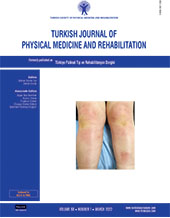Two-point discrimination assessment of the upper extremities of healthy young Turkish individuals
Patients and methods: Between March 2016 and June 2016, a total of 60 healthy students (31 males, 29 females; mean age: 22.0±1.7 years; range, 19 to 27 years) were included. Eleven grand upper limb parts which take innervation from the brachial plexus were measured with an esthesiometer.
Results: The values at the dominant sides were statistically significantly greater than the non-dominant sides at those areas: upper lateral arm (p=0.001), lower lateral arm (p=0.001), mid-posterior arm (p=0.001), mid-lateral forearm (p=0.001), mid-posterior forearm (p=0.012), skin over the first dorsal interossei muscle (p=0.031), and palmar surface of distal phalanx of the thumb (p=0.045). Both dominant and non-dominant lower lateral arm TPD measurement results increased in males compared to females, indicating a statistically significant difference (p=0.005 and p=0.011, respectively). Also, dominant and non-dominant mid-posterior arm measurement scores were found to statistically significantly increase in males compared to females (p=0.019 and p=0.040, respectively).
Conclusion: Our study results show that laterality, with lower values on the non-dominant side, but not the sex, has an effect on TPD. The findings of this study may be useful in establishing the normative data for TPD in the upper extremity parts of healthy young Turkish individuals.
Keywords : Esthesiometer, normative data, two-point discrimination, upper extremity

















